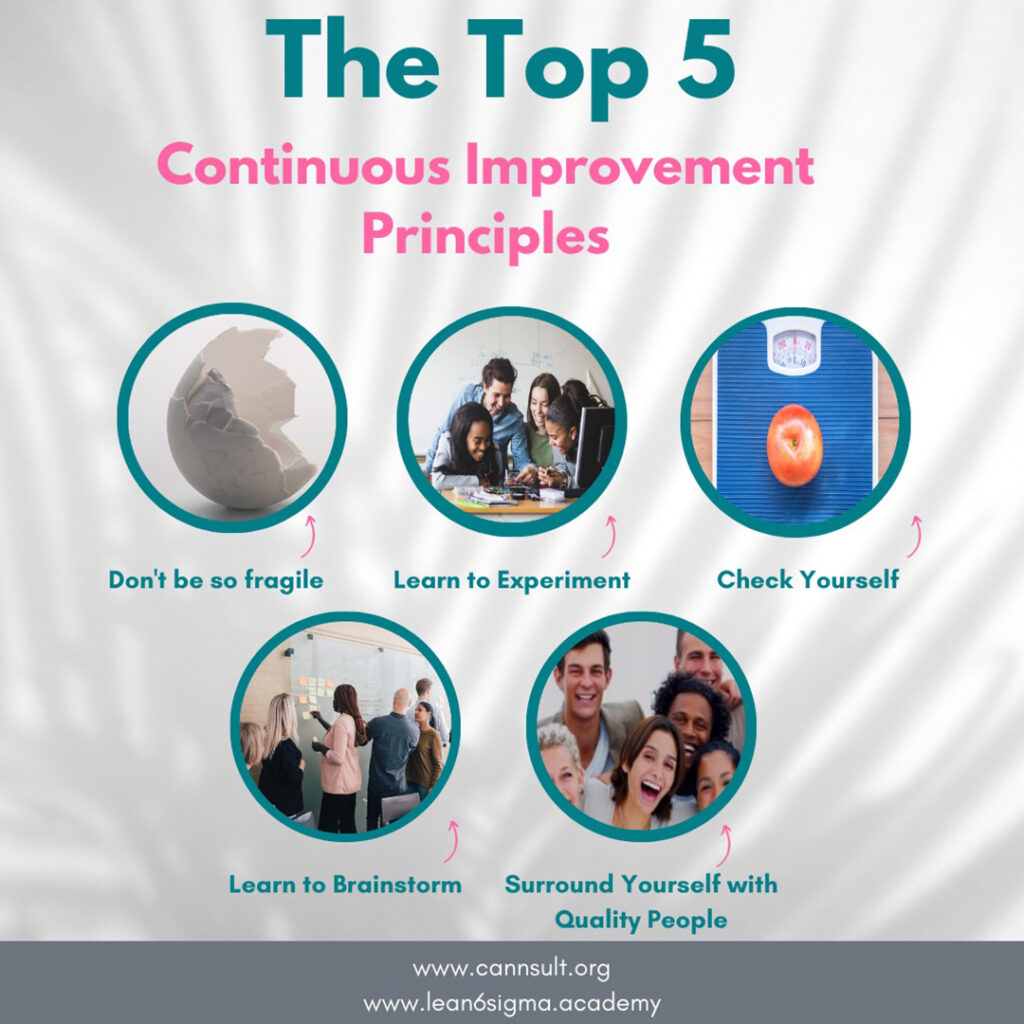Let’s talk about you, you have implemented a process improvement methodology like six sigma, and it was successful. But how would you rate your success in your career and your life up to today? When you think of “success” in your future, what does that look like specifically? Under those circumstances, one thing that becomes clear is that there is a need for continuous improvement. Continuous Improvement Principles focus on ongoing, systematic efforts to enhance processes, products, and services.
What does “Success” look like for you?
The idea of being successful is different for everyone. To some, being successful is measured by your finances. To others, it may describe a specific accomplishment or overcoming a challenge. And still, to others, it is based on a different definition of happiness.
But regardless of how you visualize success in your own career or personal life, the way to get from here to there – the Continuous Improvement Principles – remain the same.
No matter the individual definitions of success, all of our definitions share several commonalities, which is why we can all share these continuous improvement principles to turn our vision of success into a reality. The first thing that we all have in common is that – in defining our vision of success – we are all working to achieve a goal of some sort. Sure, this seems a little obvious, but when you see people who you view as quite successful, do you ever think about what it took for them to get there?
I think back to when I was 21 years old, just transplanted from Chicago to Denver, and working as a Medical Claims Processor. I would study the executive leaders and I wondered how they got to that point. And mostly I obsessed over how I could follow the path of the good ones and avoid the miserableness of the bad ones. And over my career and my life, I’ve recognized a few really important principles.
Read more: Kaizen Rapid Improvement Event

From Good to Great: Embracing the 5 Pillars of Continuous Improvement
1. Don’t be so Fragile
The only thing that allows you to continually improve is your actions. But when your actions don’t end up how you planned, you may decide to go soft on yourself, set your goals aside, and take a break from the pressure. Instead of taking further action, you might pause and wait for a better situation or better timing. While you’re waiting for the perfect opportunity to come along, you’re settling into complacency and accepting your status quo. And, BLAH! Stagnancy has arrived.
Of course, moderation is good and self-care is important. But balance is the most important thing, and we have to maintain the drive needed to get ourselves where we want to go. This means that you have to get out there and take action–even when you don’t feel like it–and you have to challenge yourself.
Continuous improvement means that you are continually doing something that will help you to progress, even though you may be fatigued or afraid. Focus on the excitement that comes along with overcoming a challenge and use that boost of adrenaline to get rid of that complacency. This will allow you to recognize and invite the opportunity to learn, grow, and continually improve.
2. Learn to Experiment
Understanding the value of experimentation is one of the key Continuous Improvement Principles because it allows you to recognize how to habitually make changes (small or big) in the seemingly permanent conditions in your life. If you start by changing and upgrading yourself and your habits, then everything in your life can begin to change.
It’s really important to understand that there can be a very subtle difference between success and failure. And your path to continually improving and reaching your goals (and then creating new ones) may be blocked by a few small daily habits or practices.
Enroll in our short course: Kaizen Rapid Improvement
In a work environment, the continuous improvement principle of experimentation starts by having a clear and shared understanding of the desired outcome, which is the only way to recognize a problem or opportunity. If we don’t know what “good” looks like, then we won’t recognize “bad”, get it? Experimentation means that we compare actual results to desired results and then take action to move the needle in the right direction. The best tools for this are Visual Performance Management and P-D-C-A (the Plan-Do-Check-Act cycle).
“Small daily improvements are the key to long-term staggering results”. – Robin Sharma
We’ve had the opportunity to be a part of these continual, incremental improvements that have had great results across industries worldwide. Check out this small sample of successful continuous improvement efforts from some of our customers:

The only thing that this continuous improvement principle of experimentation requires is discipline, which is essential for success. Only you have the unique ability to influence a positive change in your life. To do this, you must make a deliberate effort to take actions that drive toward your goals. And something I know for sure is, that you need to put in some work every day for years before you become successful in your life. Yeah, there are a lot of things that don’t work. That’s where learning comes from.
But the most beautiful part is in the moments when it works, when you’re happy, when you’re basking in the glow of your surroundings because you feel a sense of control, accomplishment, and gratitude for your life.
Read more: Bring Me a Problem, Not a Solution!
3. Check Yourself
To increase your chances of achieving your goals, you must hold yourself accountable. This is done by consistently monitoring your progress and making adjustments and corrections along the way. This means that you have to know what to measure and how to respond. Otherwise, your goal is just a poufy wish that has little likelihood of materializing. As you come closer and closer to achieving your goal, you’ll likely want to upgrade that too! That’s Continuous Improvement and it makes our passion tangible so that all of the work that we are putting forth will ultimately be worth it.
What does this look like in practice? Your goals are specific, measurable, and realistic and have an end date. The milestones to get there are the same. If this is a personal goal, you review this regularly and honestly with yourself, making adjustments as needed. If you’re working in a team, it means that you hold yourself and others accountable – and they hold you accountable. There’s nothing personal or delicate here; in a team, you are aligned around a common, shared goal, roles are clear and the path to the goal is articulated. This continuous improvement principle of checking yourself shows that we mean it. We’re not just talking the talk. We measure, monitor, and drive towards completion. We are aligned and our diverse talents, skills, and perspectives are a source of strength. Feel that energy? That’s what it’s like to be on the road to success.
Creating and holding to a plan gives you power over the direction of your life. This means that you set your own standards for performance that live somewhere between where you are today and the stars.
Enroll in our short course: Phases of DMAIC
4. Learn how to Brainstorm
Brainstorming is one method to get a team to share what’s inside their heads and gather a powerful list of potential options. Brainstorming provides a free and open environment that encourages diverse ideas and creative thinking. It does take some skill to successfully facilitate a brainstorming session.
The first step for brainstorming is to clarify the objective: Are we brainstorming potential problems? Possible measures? Root causes or ideas for solutions? We want to make sure that the desired outcome is clear before the meeting begins.
The next step is to select the participants: Invite team members, subject matter experts as well as new people. If the same team brainstorms together regularly, the ideas can get stale. Invite people with different perspectives to generate a diversity of thought.
The third step is to determine how and when we will conduct the session…remember that the space and the method have a big impact on how people work, think and feel. When a team is constantly brainstorming together in the same room, with the same group of people, the brainstorms may feel repetitive and uninspiring.
When a brainstorming session misses—whether it feels unproductive, repetitive, or negative—the team may collectively feel uninspired. On the other hand, productive group brainstorming leaves us feeling energized, accomplished, and excited for the next steps.
Read more: Kaizen deep dive
5. Surround yourself with Quality People
Have you ever heard of the idea that you are the average of the 5 people you spend the most time with? If you surround yourself with successful, driven, accomplished, happy people, your chances of success are so much greater. These 5 special people in your life become your support and your inspiration.
The key to choosing the people you spend the most time with is to ensure that you select people who cause you to reach higher to believe in a better future. If you’re the smartest or most successful person in the room, you’re losing out on the opportunity to continually improve yourself.
As you find yourself moving along your path, your 5 main people may come and they may go. They will evolve as their roles and your roles change and as you meet new people and encounter new situations. Your lifelong friendships will always be there, but we may focus our relevant time more strategically when it comes to designing and creating an improved future. Make it a point to spend time with people who can help to teach and inspire you.
Alternatively, if there are people in your life who do not share your values, are negative, self-absorbed, or detrimental to your success in some way, gracefully create a good amount of space between you and fill that space with people who will inspire and support your goals for your life.
Continuous Improvement Principles…improve every day, even if it’s just a bit.
Daily incremental improvements are key to your success. You must learn to embrace and enjoy being a life-long learner. You have to take consistent action, test various ideas, fail, get back up, and slowly see your growth. Sometimes we don’t even recognize how far we’ve come until we look back 3 or 4 or 5 years. Just like compounding your financial growth by consistently adding bit by bit to your bank account, you can become an unstoppable force by applying these continuous improvement principles.
Maintaining a continual improvement mindset allows you to see and grasp every opportunity to be a better employee, a better parent, a better partner, or whatever. As you know, success never happens overnight. But if you apply these continuous improvement principles, if you take action towards your goals every day, then you will be successful.










